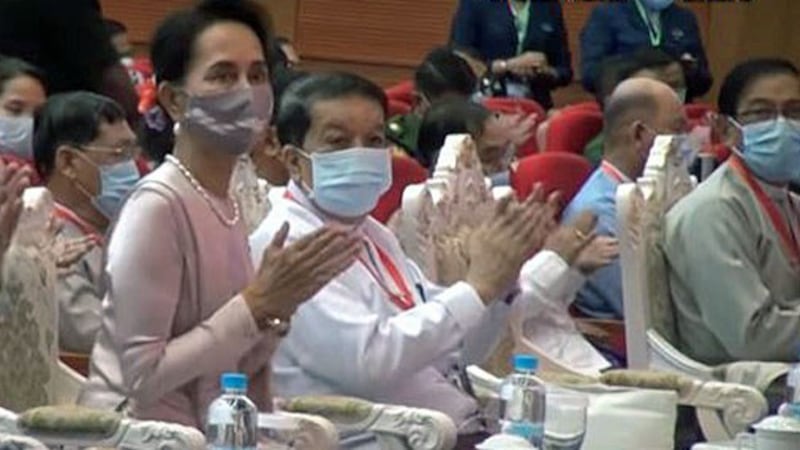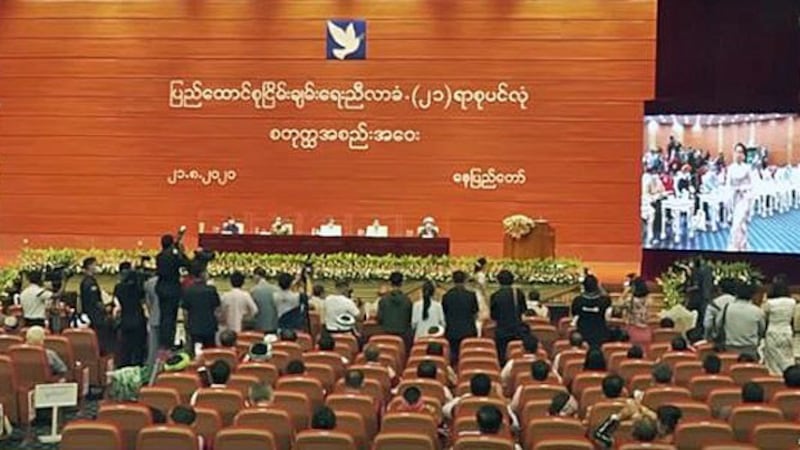Myanmar’s powerful military accepted the concept of federalism on Friday after decades of resistance to the idea, signing an agreement on the final day of government-sponsored peace talks to set the stage for building a democratic federal union after 2020.
The shift reverses 70 years of military rejection of a federal union for the complex multiethnic nation, but analysts said the latest agreement was thin on concrete achievements. The hard work lies ahead as the national army continues to fight wars in far-flung states dominated by ethnic minority groups, they said.
The fourth round of the Union Peace Conference included 230 representatives from the government, the military, political parties, and the 10 ethnic armed organizations that have signed the government’s nationwide cease-fire agreement (NCA). Seven rebel forces, including the largest and most powerful ones, stayed away.
Myanmar military spokesman Brigadier General Zaw Min Tun of military information committee later told reporters that rebel groups that have not signed the NCA must lay down their arms and sign the cease-fire pact so the peace process can move forward.
“The military believes that any peace negotiations without a cease-fire could still be problematic,” he said.
The government military has been battling Arakan Army (AA) forces in parts of Rakhine and Chin states since late 2018, leaving scores of civilians dead and displacing about 200,000 others. Clashes between national troops and ethnic soldiers also continue to occur in fits and starts in Kachin, Shan, and Kayin states.
The Myanmar government, which declared the AA a terrorist organization earlier this year, did not invite them to the conference. Seven other ethnic armies that have not signed the NCA declined invitations as a show of solidarity with the AA.
Despite the hurdles, analysts said the fourth round of talks in five year — and the last before November general elections — made some rare forward movement.
“Before, no one would bring up federalism,” said political analyst Than Soe Naing, commenting on the agreement by the military and the government at Friday’s meeting. “Now they seemed to believe that they need to agree on the basic principles of federalism.”
“They now realize that the military conflicts should be resolved on the table politically,” he said. “They came to realize this after 70 years of armed conflicts, making it the longest-running civil war in the world.”
“We should welcome this as prospect for peace and for building a federal and democratic nation for our country,” he added.

Blueprint for the process
The representatives at the Union Peace Conference, a series of meetings aimed at ending various ethnic insurgencies that have ravaged Myanmar since its founding in 1948, agreed on Union Accord Part III, the blueprint for implementing a process for creating a democratic federal union process.
First inked at the 2016 round of the Union Peace Conference, the accord comprises a framework agreement for implementing the NCA, steps for implementing the peace process after 2020, and basic principles for establishing a democratic federal union.
They also settled on several principles to resolve misunderstandings over the NCA’s implementation.
State Counselor Aung San Suu Kyi said that the agreement signed at this week’s conference is more meaningful than the two previous ones because the stakeholders have overcome differences over secession issues and have demonstrated a determination to create a single union.
Friday’s action opens the door for ethnic armed groups that have not signed the NCA to join the program and advances the implementation of Part III of the accord, Aung San Suu Kyi said.
“During the past four years, we have had many experiences regarding peace negotiations, political discussions, and the joint monitoring of the peace agreement, and we learned about their weakness and strengths,” she said.
Naing Han Thar, chairman of New Mon State Party, an NCA-signatory group from southeastern Myanmar that attended the peace conference, said more talks between the parties are needed.
“If we maintain predetermined mindsets, then we can’t make progress. … We need to change the strategy. The best strategy is to make changes through negotiations.” he said.
The Restoration Council of Shan State/Shan State Army-South, another NCA signatory, said the signing the agreement was partially satisfactory because of certain principles between the central and state governments on the division of finances, taxation, and revenue and power sharing, though the details must be negotiated in the future.

More discussions needed
Ethnic affairs analyst Maung Maung Soe said the participants at this year’s Union Peace Conference failed to make headway on forging peace.
“I think this year’s Panglong conference hasn’t made any progress,” he said, referring to the 21st-Century Panglong Conference, another name for the peace talks.
“The agreements made at today’s meeting are very general and agreeable for both sides, [but] in reality, they haven’t touched the serious issues. They still need to have many more discussions and negotiations.”
Aung Thu Nyein, director of communications at the Institute for Strategy and Policy-Myanmar, agreed.
“The processes for a cease-fire started in 2012, [but] now it is 2020,” he said.
“They are taking so long. I think there is no other solution than for the government to show greater magnanimity toward the ethnic armed groups.”
The parties agreed to 51 principles in the first two parts of the Union Accord, but nothing was said about how the agreements would be implemented — a shortcoming that delayed the implementation of agreements made after ethnic armies signed the NCA, Aung Thu Nyein said.
“The various ethnic groups wish for mere agreements that the talks will be continued after 2020 no matter whichever political party forms the new government,” he said. “The ruling NLD [National League for Democracy] government views the completion of the conference as a political achievement.”
Friday was the third day of the fourth round of the Union Peace Conference, and the final one to be held under the NLD before general elections on Nov. 8. Other conferences were held in August 2016, May 2017, and July 2018.
Aung San Suu Kyi’s father, independence hero General Aung San, arranged the first Panglong Conference in 1947 to grant autonomy to the Shan, Kachin, and Chin ethnic minorities when he was head of an interim government as Myanmar prepared to gain its independence from colonial rule by Britain.
But his assassination in July 1947 prevented the agreements made during the conference from reaching fruition, and many ethnic groups then took up arms against the central government in wars that went on for decades.
Reported by Thiha Tun, Thet Su Aung, and Soe San Aung for RFA’s Myanmar Service. Translated By Ye Kaung Myint Maung. Written in English by Roseanne Gerin.

